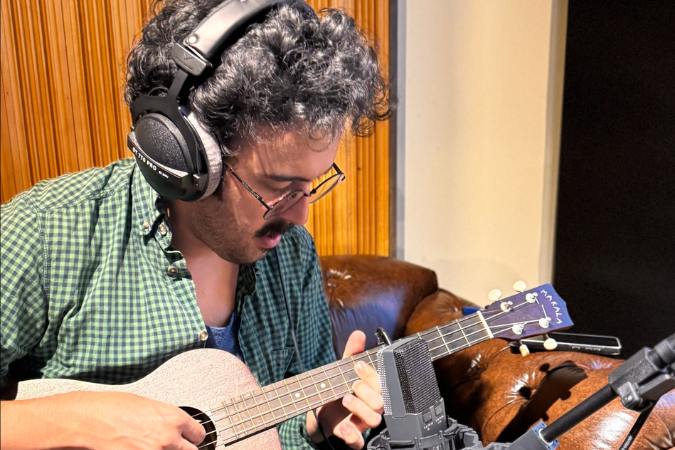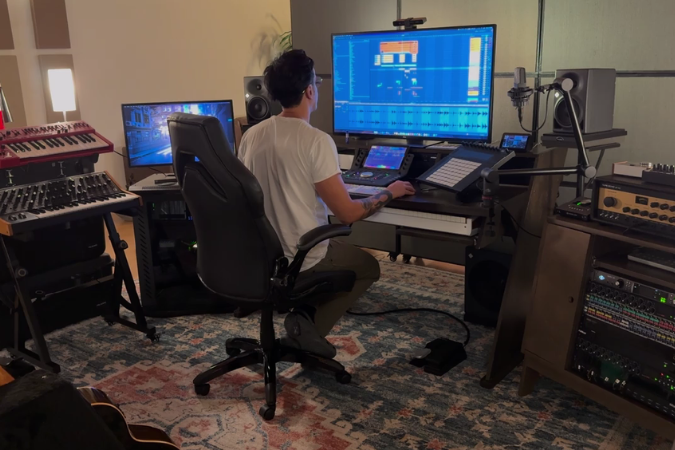The emotional core of Matabeleland lies not just in its storytelling, but in its music, crafted by the amazing duo of Eduardo Aram and Gabriel Milliet.
In this conversation, the two composers reflect on their creative process, the emotional atmosphere they sought to evoke, and the unexpected turns that shaped the final score. From São Paulo to Los Angeles, and across to Nairobi, this is a story of sonic intuition, cross-cultural collaboration, and the power of music to hold both grief and joy in the same breath.
1. When you receive a creative brief, what kind of information do you find most useful? How did those first conversations with the director and producer help shape your approach to Matabeleland?
Eduardo Aram: I strive to understand the perspectives of the director and producer for the movie, and, if both are aligned, I can bring my tools to create a musical universe that accommodates their views while still staying true to my personal taste and artistic style. If they are not aligned yet, we must rediscuss what the movie needs before I take action.
In the case of Matabeleland, Soko and I previously worked together, and he was familiar with my style of composition, which makes the process easier for everybody.
2. Matabeleland explores deep emotions; memory, identity, healing, but also carries moments of joy. What kind of emotional atmosphere were you aiming to create with the music?
Eduardo Aram: Sam and Nyasha were looking for music that conveys a lot with minimal words. This means the music shouldn't be over-the-top or melodramatic; it should be introspective at times, experimental at others, and occasionally funny and cheerful. The story of Chris and his girlfriend serves as a microcosm within a much larger, complex social and historical context. It made sense to translate this smaller universe with a quieter and more intimate score.
3. Were there any scenes that helped you discover the sound of the film? Moments where everything just clicked musically?
Eduardo Aram: The very first cue was that moment. Gabriel and I started with a temporary piece of music that wasn't perfectly aligned in terms of tempo, size, and instrumentation, but it featured a classical chord progression that we both liked. After watching the movie, I felt that using more raw instruments that don't require amplification would be the right direction. So, we began with the classical guitar. Gabriel's vocals also added an organic touch that perfectly symbolized the idea of Chris's father haunting him. Since that cue worked so well in our view, we decided to continue developing the music with the concept in mind.
4. You co-composed the score. What was your process like working together? Did you divide scenes, build on each other’s ideas, or lean into different strengths?
Eduardo Aram: During my visit to Brazil, my home country, Gabriel and I collaborated on about 60% of the ideas and structure for the cues. We recorded them in my studio in São Paulo. Later, when I returned to my headquarters, where I have my main recording studio and music company in Los Angeles, I handled the post-production. I added more elements, arranged, and mixed the music. Throughout this period, Milliet and I worked remotely, sharing files and writing four more cues.
Co-scoring is typically divided by scenes, with most operations carried out remotely in different studios. It is very unusual for composers to sit together in the same studio to compose a film score. However, this time I was excited to collaborate in person since we were both in Brazil at the same time. The last opportunity we had to do this was in 2016 while working on the score for the Olympics Opening Ceremony, a massive project where we were both part of the same team composing the music.
Gabriel Milliet: As Eduardo already mentioned, it is unusual for two composers to sit together in the same room and produce a score, but the truth is, it was a fluid and fun creative process to be together in. Eduardo has a very organized and precise vision of the composing and producing processes, and we mainly let the music ideas speak for itself while shaping it into our vision for the film. We do have crossings in our aesthetic taste for film music, which helps, but above that I think the openness to collaborate was there from the start, and that was the key point.

5. Is there one piece of music in the film that’s especially meaningful to you? A track or moment that still moves you, or that you’re particularly
proud of?
Eduardo Aram: My favorite cues are "Matabeleland Prelude" (the first scene) and "Healing the Dead." I especially enjoy "Healing the Dead" because I accidentally played this particular guitar style while scoring it. The last time I used this style was while working on "El Chapo" in 2016, which depicted scenes set in rural areas. I think this guitar style complements the earthy tones and gritty atmosphere of the scene beautifully.
Gabriel Milliet: I really like the atmospheric ones, like the cue we named “The City” – I always find it challenging to create atmospheric music without being stuck with generic sounds, and I believe we managed to create an original sound palette for the film, both with our recordings but also in the wat Eduardo post produced and mixed the tracks.
6. From a craft perspective, what instruments or tools did you rely on most for this score? Did you try anything new or unexpected in your process?
Eduardo Aram: We used various acoustic instruments, including a nylon guitar, a baritone ukulele, and a flute. Milliet provided the lead vocals and played the lead flute. Additionally, we incorporated two pads made of bamboo sounds sampled to the keyboard, along with tape echo, reverb, and light percussion using congas, shakers, and maracas. The credits roll sequence is the only part that is busier, as it features a brass ensemble layered on top of the other instruments I mentioned. Since we don’t speak the native language, we chose not to include lyrics. Where we needed to be more expressive and faced limitations with lyrics, we relied on the flute. Both of us played the keyboards, acoustic guitars, and ukuleles, occasionally jamming together, while I handled the percussion.
7. What challenges did you face while scoring this film? Were there any moments that pushed you creatively or technically?
Eduardo Aram: I have created several documentaries set in African scenarios, including "Runner" (South Sudan), "Mount Mutombo" (Democratic Republic of the Congo), "Free Money" (Kenya), and "Chain of Command" (West Africa). During these projects, I conducted research and collaborated with local talents who taught me various concepts of African music. While I don’t consider myself a specialist in African music, far from it, I was able to extract essential elements to incorporate into my film score style. I also consulted with Sam & Nyasha a few times to ensure that I wasn't misusing any elements. Although the score may not be strictly African music, it fits well within the film's aesthetic.
8. What do you hope audiences feel when they hear your music even if they don’t consciously notice it? What emotional or sensory impression are you hoping to leave behind?
Eduardo Aram: The story of Chris and his girlfriend is set against a backdrop of deeper social and political realities. It made sense to translate that contrast between personal intimacy and historical weight with a quieter, more reflective score. My hope is that even if the music goes unnoticed, it leaves behind an emotional trace that feels honest and rooted in the story’s emotional truth.
9. Matabeleland was a collaboration across cultures and borders. In what ways did that cross-cultural process impact the final outcome and do you feel the film benefited from it?
Eduardo Aram: One of my favorite aspects of this film score is the collaboration involved. This was my first project with Nyasha Kadandara and Jordan Inaan, as well as a comeback collaboration with Sam Soko. I also had a unspected encounter with Milliet at a party in Brazil. Gabriel suggested, "Hey, let's try making some music before we travel again," and the next day I received an email about the Matabeleland project. Additionally, I reconnected with Eric Wainaina. We recorded the open titles song in Kenya in 2022, but we hadn't used that material until now. I took his recordings, reworked them, and recorded drums on top of his arrangement, creating a new mix. This project has truly connected people from the US, Kenya, and Brazil. I greatly appreciate projects that involve multiple cultures and talents.
Gabriel Milliet: I feel the same – it is a joy when an encounter of many talents from different cultures join and find a good balance. I believe process like this help us finding bridges between our cultures and artistic expressions. When there is focus and respect for creative work, both the similarities and differences we have end up summing for good.
